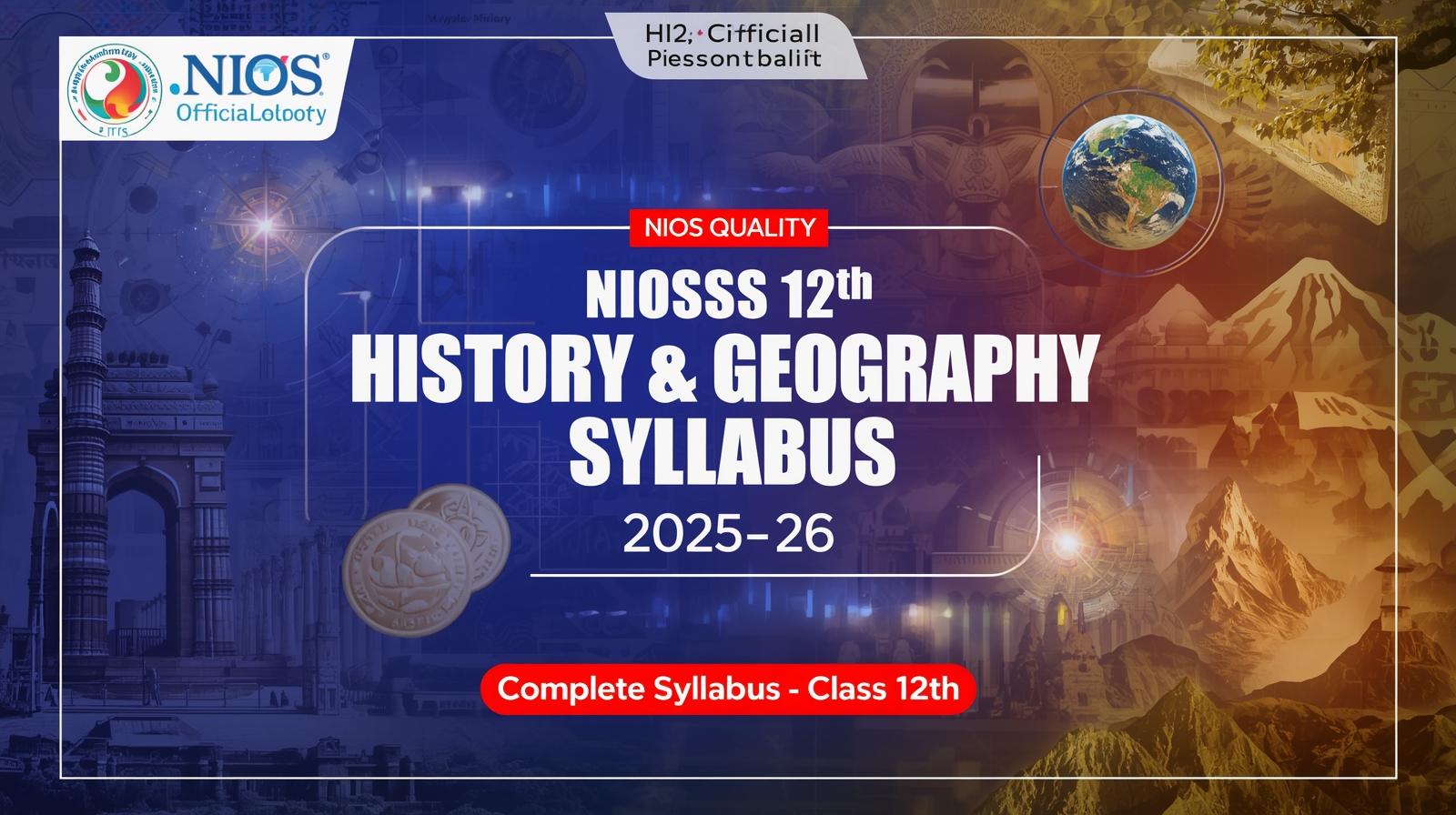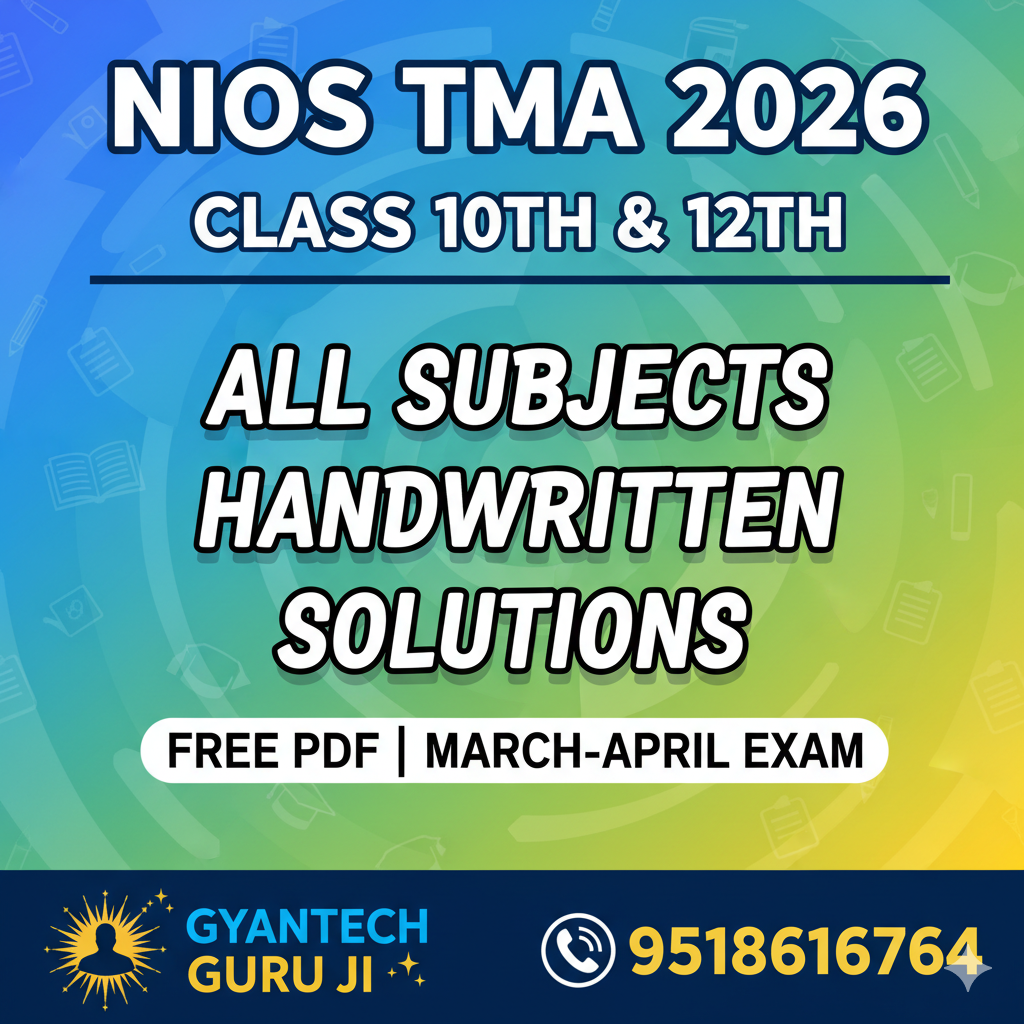NIOS Class 12th History Syllabus for 2025-26
The NIOS Class 12 History syllabus for 2025–2026 comprises 32 lessons, divided into two main parts. The syllabus is structured with 40% (12 lessons) allocated to the Tutor Marked Assignment (TMA) and 60% (20 lessons) to the Public Examination. Further details regarding the syllabus modules can be found below the table.
| Module (No. & name) | (No. of lessons 12) | (No. of lessons 20) |
|---|---|---|
| 1. Ancient India | L-1. Understanding Indian History L-2. The Geographical Setting and prehistoric cultures of India. L-5. From Janapadas to Empire L-8. India Between AD 750–1200 | L-6. Post Mauryan Developments L-7 The Guptas and Their Successors (A.D.300–750) L-3. The Harappan Civilization L-4. The Vedic Age (1500 BC–600BC) |
| 2. Medieval India | L-11. Emergence of Regional States in India: Twelfth to Eighteenth Century L-13. Economy of Medieval India L-15. Understanding Eighteenth Century India | L-9. Establishment and Expansion of the Delhi Sultanate L-10. Establishment of the Mughal Rule L-12. Administrative System and Institutions L-14. Cultural Developments in Medieval India |
| 3. Modern India | L-17. Economic changes | L-16. Establishment of British rule in India till 1857 L-18. Social changes L-19. Popular resistance to company rule |
| 4. Indian National Movement and Contemporary India | - | L-20. Nationalism L-21. National Movement & Indian Democracy |
| 5. 20th Century World | L-22. Legacy of 19th Century L-26. National Liberation Movements L-27. Social Transformation in the Twentieth Century | L-23. World War I and the Russian Revolution. L-24. The Inter War Period and the Second World War L-25. Cold war and its effects L-28. Changes in the Twentieth Century |
| 6A. Evolution of States in India OR 6B. Culture in India | L-29A Towards Formation of State L-30A. Early States L-32A. Colonial State L-29B. Contemporary Cultural Situation L-30B. Cultural Production L-31A. Medieval States L-31B. Cultural Communication |
NIOS Class 12 History Question Paper Design
Weightage by Objectives
| Objective | TOTAL | % of the total marks |
|---|---|---|
| Knowledge | 26 | 26% |
| Understanding | 52 | 52% |
| Application | 22 | 22% |
| Total | 100 | 100% |
Weightage by Type of Questions
| Types of questions | No. Of questions | Marks per Question | Total marks |
|---|---|---|---|
| Objective Type Questions 1 Marks (MCQ) | 20 | 1 | 20 |
| 1x2=2 Marks (with two sub-points) (fill in the blanks, match the column, paragraph or case-based Questions, one-word questions, true/false, etc.) | 15 | 2 | 30 |
| Very Short Answer (VSA) | 6 | 2 | 12 |
| Short Answer (SA) | 6 | 3 | 18 |
| Long Answer Type (LA) | 3 | 5 | 15 |
| Skill (Map) | 1 | 5 | 5 |
| Total | 51 | 100 |
Weightage by Contents
| Modules | Marks |
|---|---|
| Ancient | 20 |
| Medieval India | 20 |
| Modern India | 15 |
| Indian National Movement and Contemporary India | 15 |
| Contemporary World | 15 |
| 6. A. Evolution of State OR 6.B. Culture in India | 15 |
| Total | 100 |
Difficulty Level of the Question Paper
| Estimated Level | Marks | Percentage of marks |
|---|---|---|
| Difficulty | 25 | 25% |
| Average | 50 | 50% |
| Easy | 25 | 25% |
| Total | 100 | 100% |
Note: 3 Questions will have internal choice, 3 Questions will have internal choice, 2 Questions will have internal choice.
NIOS Class 12th Geography Syllabus for 2025-26
The NIOS Class 12 Geography syllabus for 2025–2026 comprises 25 lessons, divided into two main parts. The syllabus is structured with 40% (9 lessons) allocated to the Tutor Marked Assignment (TMA) and 60% (16 lessons) to the Public Examination. Further details regarding the syllabus modules can be found below the table.
| MODULE | (9 lessons) | (16 lessons) |
|---|---|---|
| 1. The study of Geography as a discipline | L-1: Nature and subject matter of Geography | |
| 2. Dynamic and Geomorphic Processes of the Earth | L-2: Endogenic Forces L-4: Running water, moving ice, wind and sea wave | L-3: Exogenic Forces and their resultant landforms |
| 3. The domain of the water on the earth | L-5: Hydrological Cycle and Ocean | |
| 4. Dynamics of Atmosphere | L-6: Structure and composition; Insolation L-8: Humidity and precipitation | L-7: Atmospheric pressure and winds L-9: Climate and Climate Change |
| 5. Biogeography and Biodiversity | L-10: Biosphere, Biomes and Biodiversity | |
| 6. Physical Geography of India | L-13: Natural Hazards and Disasters | L-11: Physical Settings L-12: Climate |
| 7. Natural resources, Utilisation and Management | L-14: Land and Soil Resources | L-15: Forests and Biodiversity L-16: Water Resources |
| 8. Economic Geography of India | L-19: Major Industries and Industrial Complexes | L-17: Agriculture and Food Security L-18: Mineral and Energy Resources L-20: Foreign Direct Investment (FDI), Transport, Communication and Trade |
| 9. Human resource development in India | L-21: Population Growth and Distribution | L-22: Population Composition L-23: Human Development |
| 10. Contemporary Issues and Challenges | L-25: Environment, Health and Sanitation | L-24: Sustainable Development Goals (SDGs) |
NIOS Class 12 Geography Sample Paper 2025-26
NIOS Class 12 Geography Sample Paper 2025 PDF - Download Here
NIOS Class 12 Geography Question Paper Design
Weightage by Objectives
| Objective | TOTAL | % of the total marks |
|---|---|---|
| Knowledge | 28 | 35% |
| Understanding | 36 | 45% |
| Application/Skill | 16 (Application-8, Skill-8) | 20% (10+10) |
| Total | 80 | 100% |
Weightage by Type of Questions
| Forms of Questions | No. of Question | Total Marks |
|---|---|---|
| Objective Type Questions 1 Marks | 16 | 16 |
| 2 Marks (with two sub-points) | 10 | 20 |
| Objective Types Map Question – 1 | 04 | |
| MAP Q. (VSA) - 2 | 2 | 4 |
| Short Answer (SA) - 3 | 5 | 15 |
| Long Answer (LA) - 5 | 1 | 5 |
| Total | 46 | 80 |
Note: * - Alternative questions to be given in lieu of the Map-based Question for the Visually Impaired candidate.
Weightage by Contents
| Module | Marks |
|---|---|
| I. The study of Geography as a discipline | 02 |
| II. Dynamic and Geomorphic Processes of the Earth | 10 |
| III. The domain of water on the Earth | 06 |
| IV. Dynamics of Atmosphere | 10 |
| V. Biogeography and Biodiversity | 4 |
| VI. Physical Geography of India | 10 |
| VII. Natural resources, Utilisation and Management | 10 |
| VIII. Economic Geography of India | 10 |
| IX. Human Resource Development in India | 8 |
| X. Contemporary Issues and Challenges | 10 |
| Total | 80 |
Difficulty Level of the Question Paper
| Estimated Level | Marks | Percentage of marks |
|---|---|---|
| Difficulty | 20 | 25% |
| Average | 40 | 50% |
| Easy | 20 | 25% |
| Total | 80 | 100% |




